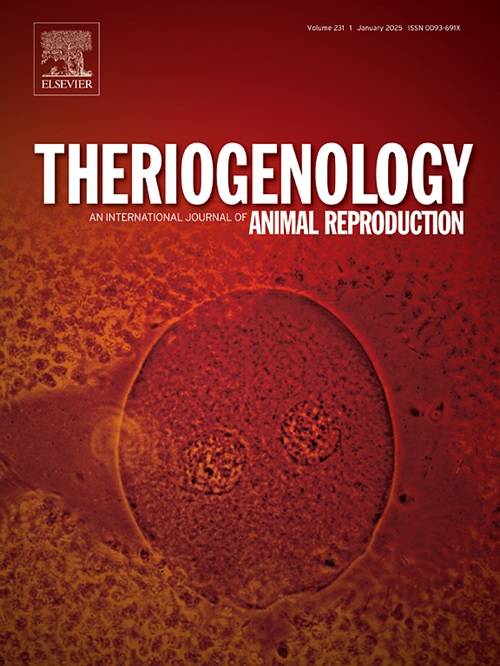纯净和经胶原酶处理的骆驼精子中的脂质和脂肪酸概况
IF 2.4
2区 农林科学
Q3 REPRODUCTIVE BIOLOGY
引用次数: 0
摘要
精子质膜的脂质组成对于受精和冷冻保存技术都是至关重要的。羊驼精浆具有独特的流变学特性,蛋白水解酶已被用于提高精液的处理。本研究的目的是评价骆驼纯精液精子的质膜脂组成,并将其与用胶原酶孵育的纯精液精子进行比较,以确定胶原酶可能参与膜脂的作用。此外,我们还研究了夏季和冬季以及年轻动物和成年动物之间收集的精子脂质组成的差异。从6只大羊驼获得52次射精,并对常规精液参数进行了评估。测定了纯精液和胶原酶孵育后精子的胆固醇(Chol)、磷脂(PL)、Chol/PL比值、脂肪酸(FA)组、单个FA和PL类别。纯精精子的Chol、PL、Chol/PL比值、FA和PL种类与胶原酶孵育的精子无显著差异。当按季节比较这些相同的参数时,没有观察到显著差异。与成年雄鱼相比,年轻雄鱼干净精液中PL含量显著降低,且Chol、Chol/PL比值和多不饱和脂肪酸百分比呈升高趋势。总之,本研究确定了整齐羊驼精子的脂质组成,表明胶原酶处理不会改变它。虽然没有观察到季节差异,但在精子脂质组成方面发现了显著的年龄相关差异。这一发现提供了对骆驼精子脂质的深入了解,可能与冷冻保存有关。本文章由计算机程序翻译,如有差异,请以英文原文为准。
Lipid and fatty acid profile in neat and collagenase-treated llama sperm
The lipid composition of spermatozoa plasma membranes is crucial for both fertilization and cryopreservation techniques. Llama seminal plasma has unique rheological characteristics and proteolytic enzymes have been used to enhance semen handling. The purpose of this study was to evaluate the plasma membrane lipid composition of llama sperm from neat semen and to compare it with sperm from neat semen incubated with collagenase, as an attempt to determine the possible involvement of collagenase over membrane lipids. Also, we investigate the differences in lipid composition of sperm collected in summer versus winter, and between young and adult animals. Fifty-two ejaculates from six llamas were obtained and routine seminal parameters were evaluated. Cholesterol (Chol), phospholipids (PL), Chol/PL ratio, fatty acid (FA) groups, individual FA, and PL classes were evaluated in sperm from neat semen and after incubation with collagenase. No significant differences were found in Chol, PL, Chol/PL ratio, FA, and PL classes between neat semen spermatozoa and those incubated with collagenase. When comparing these same parameters by season, no significant differences were observed. Younger males showed significantly lower PL content in sperm from neat semen, with a trend of higher Chol, a higher Chol/PL ratio, and lower polyunsaturated FA percentages compared to adult males. In conclusion, this study identified the lipid composition of neat llama spermatozoa, showing that collagenase treatment does not alter it. While no seasonal differences were observed, significant age-related differences in sperm lipid composition were found. The findings provide insights into llama sperm lipids, potentially relevant for cryopreservation.
求助全文
通过发布文献求助,成功后即可免费获取论文全文。
去求助
来源期刊

Theriogenology
农林科学-生殖生物学
CiteScore
5.50
自引率
14.30%
发文量
387
审稿时长
72 days
期刊介绍:
Theriogenology provides an international forum for researchers, clinicians, and industry professionals in animal reproductive biology. This acclaimed journal publishes articles on a wide range of topics in reproductive and developmental biology, of domestic mammal, avian, and aquatic species as well as wild species which are the object of veterinary care in research or conservation programs.
 求助内容:
求助内容: 应助结果提醒方式:
应助结果提醒方式:


